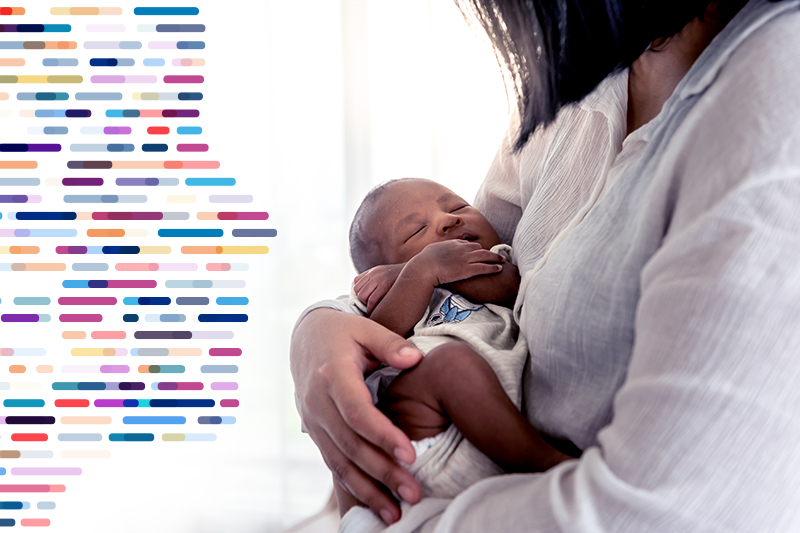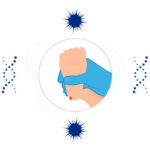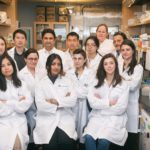Bringing equity to genomic sequencing in newborns: BabySeq 2.0

Today, nearly 900 disorders caused by a single gene are known to be treatable. Yet the recommended “heel stick” testing for newborns only covers about 60 inherited, treatable disorders, and many individual states screen for fewer. What if newborns could instead have their entire genome sequenced at birth, with the results shared and acted on as appropriate?
That was the premise behind the original BabySeq study. That study ran from 2013 to 2019 at the NICU and other ICUs at Boston Children’s Hospital, and at the well-baby unit at Brigham and Women’s Hospital. Of 159 newborns whose families opted to participate, 11 percent had unanticipated genetic variants associated with disease. All findings were medically actionable, meaning that the child could benefit from early treatment or surveillance. In some cases, findings prompted family members to have genetic testing and medical consultations themselves.
The families that enrolled in the original study were primarily white and of higher socioeconomic status.
Could newborn genomic sequencing be feasible in a broader, more diverse population? Ingrid Holm, MD, MPH, co-investigator on the original BabySeq study, is now co-leading a new study — BabySeq2 — that aims to find out. It runs through 2025.
“Although the nurseries in the original study had very diverse populations, the families that enrolled — only about 10 percent of those we approached — were primarily white and of higher socioeconomic status,” Holm says.
She and her colleagues realized they needed to take the study out of academic medical centers and into the community — and also reconsider the study design.
Rethinking the BabySeq study design
BabySeq2 is based in community health centers serving families from diverse racial and socioeconomic backgrounds. These currently are the Boston Children’s Primary Care Center, Mount Sinai (New York)’s Pediatric Associated Practice, the Children’s of Alabama Primary Care Clinic, and Corewell Health Pediatric Practices in Detroit.
The team’s first step, new to this study, was to form a Community Advisory Board of mothers drawn from each participating clinic. With the Board’s help, the BabySeq2 team interviewed families to inform the design of the study before it started.
“This experience really helped us structure our thinking,” says Holm, who now chairs the Institutional Review Board at Boston Children’s. “There’s a lot of well-founded distrust in research, in genetics, and in health care in underserved communities. Saying, ‘we’re going to sequence your baby’ can feel kind of threatening. The interviews helped us understand families’ concerns and what’s important to families.”
The BabySeq2 team provides materials in both English and Spanish and strives to recruit research assistants who speak Spanish or come from the neighborhood around the clinic. But several other important things also changed based on family feedback.
One is how the study enrolls infants. In the initial BabySeq project, researchers approached families soon after a birth. In BabySeq2, infants can be enrolled anytime during the first year of life by their own pediatricians. The pediatricians can opt to receive education up front about the content of the genetic reports, what to do with the findings, and how to counsel families about the findings.
“We originally went to newborn nurseries, but a lot of the parents didn’t want to hear about research right after having a baby,” says Holm. “The birth of a baby is a very overwhelming time. Instead, we’re enrolling families from clinics through their trusted pediatricians, and they have more time to think about enrolling.”
Newborn screening for the 21st century
The team also got feedback from the Board on the consent forms they had been using, starting with the reading level, which was too high.
“The Board said, ‘Why are you highlighting the risks? Why not highlight the benefits?’” says Holm. For the families, benefits included being able to prepare for the future and accept their child’s condition.
Another major change: In the initial BabySeq project, researchers collected blood samples from all enrolled newborns, then randomized some of them to undergo DNA sequencing. But the Board didn’t like the idea of blood samples being taken and not used. So BabySeq2 is taking samples only from the newborns who actually undergo sequencing. Moreover, parents are no longer asked to provide blood samples up front, but only if there’s a genetic finding in their baby.
The changes seem to be paying off: Since the study opened in January, it has enrolled about 200 families across the four sites, with about half of families approached interested in participating. As time goes on, the study will assess the medical impact of genomic sequencing on infants, families, and health care providers as well as health care costs.
Holm acknowledges that there are logistical and governance data privacy issues to be worked out before genomic sequencing could be made universally available to newborns. Moreover, newborn screening is currently run state by state.
“We hope to provide evidence for the value of genomic sequencing and show that it doesn’t increase medical costs,” says Holm. “The idea is to eventually inform policy and fundamentally change newborn screening.”
Learn more about Ingrid Holm’s research and Boston Children’s clinical Neonatal Genomics Program.
Related Posts :
-

Bringing genomics to community NICUs
About a year and a half ago, Robert Rothstein, MD, FAAP encountered a baby with a pattern of facial features ...
-

Newborn genetic screening for pediatric cancer risk could save lives
Numerous genetic mutations increase children’s risk for various cancers. When they are detected early, cancers can potentially be caught ...
-

Solving genetic mysteries – in the NICU and beyond
A growing number of children with suspected genetic disorders are having their complete exomes sequenced, since it’s now often ...
-

Genetic sequencing may open doors for newborns with hypotonia
When a baby is born with low muscle tone (hypotonia), the future is hard to predict, and families have a ...





